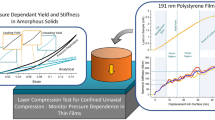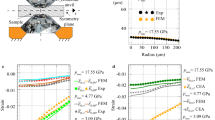Abstract
Elastic and plastic properties of materials and phase transitions at extreme conditions vary with both hydrostatic pressure and deviatoric stress. To generate and measure controlled deviatoric stress at pressures beyond those accessible with large volume differential and rotational presses and optical access for spectroscopy, experiments tested the combination of diamond anvil cell and thin film technology. Thin films of polycrystalline Cr-doped Al2O3 ruby were prepared using pulsed laser deposition on single-crystal substrates of either Al2O3 sapphire or yttria-stabilized cubic zirconia for contrasting initial film stress, and loaded in diamond anvil cells for confining stress. The piezospectroscopic response of the ruby films demonstrates consistently higher deviatoric stress in the film on zirconia relative to the film on the control sapphire, and an increase in deviatoric stress with applied load. Complementary synchrotron X-ray diffraction of the zirconia substrate confirmed that no pressure-induced phase transitions impacted the stress state of the ruby film, but differences in compressibility of film and substrate result in changes in film stress analogous to thermal expansion mismatch. This technique may be applied to evaluate elastic and plastic response of thin films of a variety of materials under extreme stress.








Similar content being viewed by others
References
Al-Khatatbeh Y, Lee KKM, Kiefer B (2010) Phase relations and hardness trends of ZrO2 phases at high pressure. Phys Rev B 81:214102. https://doi.org/10.1103/PhysRevB.81.214102
Al-Khatatbeh Y, Lee KKM, Kiefer B (2012) Compressibility of nanocrystalline TiO2 anatase. J Phys Chem C 116:21635–21639. https://doi.org/10.1021/jp3075699
Angel RJ, Bujak M, Zhao J et al (2007) Effective hydrostatic limits of pressure media for high-pressure crystallographic studies. J Appl Crystallogr 40:26–32. https://doi.org/10.1107/S0021889806045523
Asaumi K, Ruoff AL (1986) Nature of the state of stress produced by xenon and some alkali iodides when used as pressure media. Phys Rev B 33:5633. https://doi.org/10.1103/PhysRevB.33.5633
Baykan MO, Thompson SE, Nishida T (2010) Strain effects on three-dimensional, two-dimensional, and one-dimensional silicon logic devices: predicting the future of strained silicon. J Appl Phys 108:093716. https://doi.org/10.1063/1.3488635
Brugman BL (2021) Strength, deformation and compression behavior of tungsten carbide, krypton, and xenon under quasi-static loading. Michigan State University, Michigan
Cao S-G, Li Y, Wu H-H et al (2017) Stress-induced cubic-to-hexagonal phase transformation in perovskite nanothin films. Nano Lett 17:5148–5155. https://doi.org/10.1021/acs.nanolett.7b02570
Chai M, Brown JM (1996) Effects of static non-hydrostatic stress on the R lines of ruby single crystals. Geophys Res Lett 23:3539–3542. https://doi.org/10.1029/96GL03372
Chen B, Penwell D, Benedetti LR et al (2002) Particle-size effect on the compressibility of nanocrystalline alumina. Phys Rev B 66:144101. https://doi.org/10.1103/PhysRevB.66.144101
Chen B, Lutker K, Raju SV et al (2012) Texture of nanocrystalline nickel: probing the lower size limit of dislocation activity. Science 338:1448–1451. https://doi.org/10.1126/science.1228211
Chen X, Lou H, Zeng Z et al (2021) Structural transitions of 4:1 methanol–ethanol mixture and silicone oil under high pressure. Matter Radiat Extrem 6:038402. https://doi.org/10.1063/5.0044893
Chijioke AD, Nellis WJ, Soldatov A, Silvera IF (2005) The ruby pressure standard to 150 GPa. J Appl Phys 98:114905. https://doi.org/10.1063/1.2135877
Cohen RE, Mehl MJ, Boyer LL (1988) Phase transitions and elasticity in zirconia. Phys BC 150:1–9. https://doi.org/10.1016/0378-4363(88)90097-6
Cook RF, Michaels CA (2017) Review: coefficients for stress, temperature, and composition effects in fluorescence measurements of alumina. J Res Natl Inst Stand Technol. 13(122):1–26. https://doi.org/10.6028/jres.122.043
Desgreniers S, Lagarec K (1999) High-density ZrO2 and HfO2: crystalline structures and equations of state. Phys Rev B 59:8467. https://doi.org/10.1103/PhysRevB.59.8467
Dewaele A, Torrent M (2013) Equation of state of α-Al2O3. Phys Rev B 88:064107. https://doi.org/10.1103/PhysRevB.88.064107
Dong H, Dorfman SM, Wang J et al (2014) The strength of ruby from X-ray diffraction under non-hydrostatic compression to 68 GPa. Phys Chem Miner. https://doi.org/10.1007/s00269-014-0664-2
Dorfman SM, Prakapenka VB, Meng Y, Duffy TS (2012) Intercomparison of pressure standards (Au, Pt, Mo, MgO, NaCl and Ne) to 2.5 Mbar. J Geophys Res 117:B08210. https://doi.org/10.1029/2012JB009292
Dubrovinsky LS, Saxena SK, Lazor P (1998) High-pressure and high-temperature in situ X-ray diffraction study of iron and corundum to 68 GPa using an internally heated diamond anvil cell. Phys Chem Miner 25:434–441. https://doi.org/10.1007/s002690050133
Finger LW, Hazen RM (1978) Crystal structure and compression of ruby to 46 kbar. J Appl Phys 49:5823–5826. https://doi.org/10.1063/1.324598
Garcia V, Sidis Y, Marangolo M et al (2007) Biaxial strain in the hexagonal plane of MnAs thin films: the key to stabilize ferromagnetism to higher temperature. Phys Rev Lett 99:117205. https://doi.org/10.1103/PhysRevLett.99.117205
Götsch T, Wallisch W, Stöger-Pollach M et al (2016) From zirconia to yttria: sampling the YSZ phase diagram using sputter-deposited thin films. AIP Adv 6:025119. https://doi.org/10.1063/1.4942818
Grabner L (1978) Spectroscopic technique for the measurement of residual stress in sintered Al2O3. J Appl Phys 49:580–583. https://doi.org/10.1063/1.324682
Gupta YM, Horn PD, Burt JA (1994) Effect of tension on R lines in ruby crystals shocked along crystal c axis. J Appl Phys 76:1784–1788. https://doi.org/10.1063/1.357696
Halevy I, Carmon R, Winterrose ML et al (2010) Pressure-induced structural phase transitions in Y2O3 sesquioxide. J Phys Conf Ser 215:012003. https://doi.org/10.1088/1742-6596/215/1/012003
He J, Clarke DR (1995) Determination of the piezospectroscopic coefficients for chromium-doped sapphire. J Am Ceram Soc 78:1347–1353. https://doi.org/10.1111/j.1151-2916.1995.tb08493.x
Heeg B, Tolpygo VK, Clarke DR (2011) Damage evolution in thermal barrier coatings with thermal cycling. J Am Ceram Soc 94:s112–s119. https://doi.org/10.1111/j.1551-2916.2011.04496.x
Holland TJB, Redfern S (1997) UNITCELL: a nonlinear least-squares program for cell-parameter refinement and implementing regression and deletion diagnostics. J Appl Crystallogr 30:84–84. https://doi.org/10.1107/S0021889896011673
Howard CJ, Hill RJ, Reichert BE (1988) Structures of ZrO2 polymorphs at room temperature by high-resolution neutron powder diffraction. Acta Crystallogr B 44:116–120. https://doi.org/10.1107/S0108768187010279
Issa I, Joly-Pottuz L, Réthoré J et al (2018) Room temperature plasticity and phase transformation of nanometer-sized transition alumina nanoparticles under pressure. Acta Mater 150:308–316. https://doi.org/10.1016/j.actamat.2018.03.023
Jephcoat AP, Hemley RJ, Mao HK (1988) X-ray diffraction of ruby (Al2O3:Cr3+) to 175 GPa. Phys BC 150:115–121. https://doi.org/10.1016/0378-4363(88)90112-X
Kantor I, Prakapenka V, Kantor A et al (2012) BX90: a new diamond anvil cell design for X-ray diffraction and optical measurements. Rev Sci Instrum 83:125102. https://doi.org/10.1063/1.4768541
Klotz S, Chervin J-C, Munsch P, Marchand GL (2009) Hydrostatic limits of 11 pressure transmitting media. J Phys Appl Phys 42:075413. https://doi.org/10.1088/0022-3727/42/7/075413
Leger JM, Tomaszewski PE, Atouf A, Pereira AS (1993) Pressure-induced structural phase transitions in zirconia under high pressure. Phys Rev B 47:14075–14083. https://doi.org/10.1103/PhysRevB.47.14075
Lin Z, Wang L, Zhang J et al (2009) Nanocrystalline tungsten carbide: as incompressible as diamond. Appl Phys Lett 95:211906. https://doi.org/10.1063/1.3268457
Lipkin DM, Clarke DR (1996) Measurement of the stress in oxide scales formed by oxidation of alumina-forming alloys. Oxid Met 45:267–280. https://doi.org/10.1007/BF01046985
Ma Q, Clarke DR (1993) Stress measurement in single-crystal and polycrystalline ceramics using their optical fluorescence. J Am Ceram Soc 76:1433–1440. https://doi.org/10.1111/j.1151-2916.1993.tb03922.x
Margueron SH, Clarke DR (2006) The use of polarization in the piezospectroscopic determination of the residual stresses in polycrystalline alumina films. Acta Mater 54:5551–5557. https://doi.org/10.1016/j.actamat.2006.08.017
Mashimo T, Nakamura A, Kodama M et al (1995) Yielding and phase transition under shock compression of yttria-doped cubic zirconia single crystal and polycrystal. J Appl Phys 77:5060–5068. https://doi.org/10.1063/1.359314
Molis SE, Clarke DR (1990) Measurement of stresses using fluorescence in an optical microprobe: stresses around indentations in a chromium-doped sapphire. J Am Ceram Soc 73:3189–3194. https://doi.org/10.1111/j.1151-2916.1990.tb06435.x
Nomura R, Azuma S, Uesugi K et al (2017) High-pressure rotational deformation apparatus to 135 GPa. Rev Sci Instrum 88:044501. https://doi.org/10.1063/1.4979562
Nychka JA, Clarke DR (2001) Damage quantification in TBCs by photo-stimulated luminescence spectroscopy. Surf Coat Technol 146–147:110–116. https://doi.org/10.1016/S0257-8972(01)01455-4
Ohtaka O, Fukui H, Kunisada T et al (2001) Phase relations and equations of state of ZrO2 under high temperature and high pressure. Phys Rev B 63:174108. https://doi.org/10.1103/PhysRevB.63.174108
Ohtaka O, Andrault D, Bouvier P et al (2005) Phase relations and equation of state of ZrO2 to 100 GPa. J Appl Crystallogr 38:727–733. https://doi.org/10.1107/S0021889805018145
Pascual C, Durán P (1983) Subsolidus phase equilibria and ordering in the system ZrO2–Y2O3. J Am Ceram Soc 66:23–27. https://doi.org/10.1111/j.1151-2916.1983.tb09961.x
Powell RC, DiBartolo B, Birang B, Naiman CS (1966) Temperature dependence of the widths and positions of the R and N lines in heavily doped ruby. J Appl Phys 37:4973–4978. https://doi.org/10.1063/1.1708175
Ragan DD, Clarke DR, Schiferl D (1996) Silicone fluid as a high-pressure medium in diamond anvil cells. Rev Sci Instrum 67:494–496. https://doi.org/10.1063/1.1146627
Rivers M, Prakapenka V, Kubo A et al (2008) The COMPRES/GSECARS gas-loading system for diamond anvil cells at the advanced photon source. High Press Res 28:273–292. https://doi.org/10.1080/08957950802333593
Sato Y, Akimoto S (1979) Hydrostatic compression of four corundum-type compounds: α-Al2O3, V2O3, Cr2O3, and α-Fe2O3. J Appl Phys 50:5285–5291. https://doi.org/10.1063/1.326625
Schlichting KW, Vaidyanathan K, Sohn YH et al (2000) Application of Cr3+ photoluminescence piezo-spectroscopy to plasma-sprayed thermal barrier coatings for residual stress measurement. Mater Sci Eng A 291:68–77. https://doi.org/10.1016/S0921-5093(00)00973-4
Selcuk A, Atkinson A (2002) Analysis of the Cr3+ luminescence spectra from thermally grown oxide in thermal barrier coatings. Mater Sci Eng A 335:147–156. https://doi.org/10.1016/S0921-5093(01)01911-6
Sharma SM, Gupta YM (1991) Theoretical analysis of R-line shifts of ruby subjected to different deformation conditions. Phys Rev B 43:879–893. https://doi.org/10.1103/PhysRevB.43.879
Shen XA, Gupta YM (1993) Effect of crystal orientation on ruby R-line shifts under shock compression and tension. Phys Rev B 48:2929–2940. https://doi.org/10.1103/PhysRevB.48.2929
Shen Y, Kumar RS, Pravica M, Nicol MF (2004) Characteristics of silicone fluid as a pressure transmitting medium in diamond anvil cells. Rev Sci Instrum 75:4450–4454. https://doi.org/10.1063/1.1786355
Shen G, Wang Y, Dewaele A et al (2020) Toward an international practical pressure scale: a proposal for an IPPS ruby gauge (IPPS-Ruby2020). High Press Res. https://doi.org/10.1080/08957959.2020.1791107
Smith DK, Newkirk W (1965) The crystal structure of baddeleyite (monoclinic ZrO2) and its relation to the polymorphism of ZrO2. Acta Crystallogr 18:983–991. https://doi.org/10.1107/S0365110X65002402
Stapper G, Bernasconi M, Nicoloso N, Parrinello M (1999) Ab initio study of structural and electronic properties of yttria-stabilized cubic zirconia. Phys Rev B 59:797–810. https://doi.org/10.1103/PhysRevB.59.797
Straley EM, Dorfman SM, Nicholas JD (2019) Correlation between the wafer curvature and fluorescence of pulsed laser deposited ruby thin films stressed to ~2 GPa. J Appl Phys 125:245904
Wang Q, He D, Peng F et al (2014) Compression behavior of nanocrystalline TiN. Solid State Commun 182:26–29. https://doi.org/10.1016/j.ssc.2013.12.015
Wen Q, Clarke DR, Yu N, Nastasi M (1995) Epitaxial regrowth of ruby on sapphire for an integrated thin film stress sensor. Appl Phys Lett 66:293. https://doi.org/10.1063/1.113522
Zhou X, Behera JK, Lv S et al (2017) Avalanche atomic switching in strain engineered Sb2Te3–GeTe interfacial phase-change memory cells. Nano Futur 1:025003. https://doi.org/10.1088/2399-1984/aa8434
Acknowledgements
Samples used in these experiments were provided by J. D. Nicholas and E. M. Straley. We thank M. Calderon Cueva and A. Pease for helpful discussion of single-crystal diffraction analysis. This work has been supported by the US Department of Energy, National Nuclear Security Administration, through the Capital-DOE Alliance Center (DE-NA0003858), and new faculty startup funding to S. M. Dorfman. Support for B. Arroyo was provided by the GeoCaFES program, NSF Geopaths grant 2023059. M. Lv’s contribution is based upon work supported by Laboratory Directed Research and Development (LDRD) funding from Argonne National Laboratory, provided by the Director, Office of Science, of the U.S. Department of Energy under Contract No. DE-AC02-06CH11357. Portions of this work were performed at HPCAT (Sector 16), Advanced Photon Source (APS), Argonne National Laboratory. HPCAT operations are supported by DOE-NNSA’s Office of Experimental Sciences. Use of the COMPRES-GSECARS gas loading system was supported by COMPRES under NSF Cooperative Agreement EAR-1606856 and by GSECARS through NSF grant EAR-1634415 and DOE grant DE-FG02-94ER14466. The Advanced Photon Source is a U.S. Department of Energy (DOE) Office of Science User Facility operated for the DOE Office of Science by Argonne National Laboratory under Contract No. DE-AC02-06CH11357.
Author information
Authors and Affiliations
Corresponding author
Additional information
Publisher's Note
Springer Nature remains neutral with regard to jurisdictional claims in published maps and institutional affiliations.
This article is part of a Topical Collection “Experimental & Analytical Techniques at Extreme & Ambient Conditions”, guest edited by Stella Chariton, Vitali B. Prakapenka and Haozhe (Arthur) Liu.
Rights and permissions
About this article
Cite this article
Dorfman, S.M., Najiba, S., Arroyo, B. et al. Control of deviatoric stress in the diamond anvil cell through thermal expansion mismatch stress in thin films. Phys Chem Minerals 49, 16 (2022). https://doi.org/10.1007/s00269-022-01191-9
Received:
Accepted:
Published:
DOI: https://doi.org/10.1007/s00269-022-01191-9




